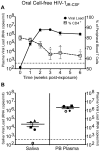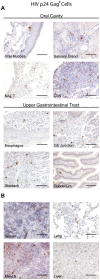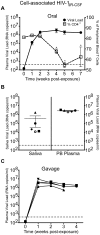Human breast milk and antiretrovirals dramatically reduce oral HIV-1 transmission in BLT humanized mice
- PMID: 22737068
- PMCID: PMC3380612
- DOI: 10.1371/journal.ppat.1002732
Human breast milk and antiretrovirals dramatically reduce oral HIV-1 transmission in BLT humanized mice
Abstract
Currently, over 15% of new HIV infections occur in children. Breastfeeding is a major contributor to HIV infections in infants. This represents a major paradox in the field because in vitro, breast milk has been shown to have a strong inhibitory effect on HIV infectivity. However, this inhibitory effect has never been demonstrated in vivo. Here, we address this important paradox using the first humanized mouse model of oral HIV transmission. We established that reconstitution of the oral cavity and upper gastrointestinal (GI) tract of humanized bone marrow/liver/thymus (BLT) mice with human leukocytes, including the human cell types important for mucosal HIV transmission (i.e. dendritic cells, macrophages and CD4⁺ T cells), renders them susceptible to oral transmission of cell-free and cell-associated HIV. Oral transmission of HIV resulted in systemic infection of lymphoid and non-lymphoid tissues that is characterized by the presence of HIV RNA in plasma and a gradual decline of CD4⁺ T cells in peripheral blood. Consistent with infection of the oral cavity, we observed virus shedding into saliva. We then evaluated the role of human breast milk on oral HIV transmission. Our in vivo results demonstrate that breast milk has a strong inhibitory effect on oral transmission of both cell-free and cell-associated HIV. Finally, we evaluated the effect of antiretrovirals on oral transmission of HIV. Our results show that systemic antiretrovirals administered prior to exposure can efficiently prevent oral HIV transmission in BLT mice.
Conflict of interest statement
The authors have declared that no competing interests exist.
Figures







Similar articles
-
Efficient Inhibition of HIV Replication in the Gastrointestinal and Female Reproductive Tracts of Humanized BLT Mice by EFdA.PLoS One. 2016 Jul 20;11(7):e0159517. doi: 10.1371/journal.pone.0159517. eCollection 2016. PLoS One. 2016. PMID: 27438728 Free PMC article.
-
Immune reconstitution of the female reproductive tract of humanized BLT mice and their susceptibility to human immunodeficiency virus infection.J Reprod Immunol. 2011 Mar;88(2):195-203. doi: 10.1016/j.jri.2010.11.005. Epub 2011 Jan 21. J Reprod Immunol. 2011. PMID: 21256601 Free PMC article. Review.
-
HIV pre-exposure prophylaxis for women and infants prevents vaginal and oral HIV transmission in a preclinical model of HIV infection.J Antimicrob Chemother. 2016 Nov;71(11):3185-3194. doi: 10.1093/jac/dkw283. Epub 2016 Aug 1. J Antimicrob Chemother. 2016. PMID: 27494916 Free PMC article.
-
Alpha interferon and HIV infection cause activation of human T cells in NSG-BLT mice.J Virol. 2012 Mar;86(6):3327-36. doi: 10.1128/JVI.06676-11. Epub 2012 Jan 11. J Virol. 2012. PMID: 22238321 Free PMC article.
-
BLT humanized mice as model to study HIV vaginal transmission.J Infect Dis. 2013 Nov;208 Suppl 2(Suppl 2):S131-6. doi: 10.1093/infdis/jit318. J Infect Dis. 2013. PMID: 24151319 Free PMC article. Review.
Cited by
-
Rectal transmission of transmitted/founder HIV-1 is efficiently prevented by topical 1% tenofovir in BLT humanized mice.PLoS One. 2013;8(3):e60024. doi: 10.1371/journal.pone.0060024. Epub 2013 Mar 20. PLoS One. 2013. PMID: 23527295 Free PMC article.
-
Nanoformulations of Rilpivirine for Topical Pericoital and Systemic Coitus-Independent Administration Efficiently Prevent HIV Transmission.PLoS Pathog. 2015 Aug 13;11(8):e1005075. doi: 10.1371/journal.ppat.1005075. eCollection 2015 Aug. PLoS Pathog. 2015. PMID: 26271040 Free PMC article.
-
Overcoming current limitations in humanized mouse research.J Infect Dis. 2013 Nov;208 Suppl 2(Suppl 2):S125-30. doi: 10.1093/infdis/jit319. J Infect Dis. 2013. PMID: 24151318 Free PMC article. Review.
-
HIV-specific CD8⁺ T-cell immunity in humanized bone marrow-liver-thymus mice.J Infect Dis. 2013 Nov;208 Suppl 2(Suppl 2):S150-4. doi: 10.1093/infdis/jit320. J Infect Dis. 2013. PMID: 24151322 Free PMC article. Review.
-
Humanized Mice for Live-Attenuated Vaccine Research: From Unmet Potential to New Promises.Vaccines (Basel). 2020 Jan 21;8(1):36. doi: 10.3390/vaccines8010036. Vaccines (Basel). 2020. PMID: 31973073 Free PMC article. Review.
References
-
- Newell ML, Coovadia H, Cortina-Borja M, Rollins N, Gaillard P, et al. Mortality of infected and uninfected infants born to HIV-infected mothers in Africa: a pooled analysis. Lancet. 2004;364:1236–1243. - PubMed
-
- Lehman DA, Farquhar C. Biological mechanisms of vertical human immunodeficiency virus (HIV-1) transmission. Rev Med Virol. 2007;17:381–403. - PubMed
-
- UNAIDS and WHO. AIDS Epidemic Update: 2009. AIDS Epidemic Updates. Geneva: The Joint United Nations Programme on HIV/AIDS and the World Health Organization; 2009.
-
- Saeland E, de Jong MA, Nabatov AA, Kalay H, Geijtenbeek TB, et al. MUC1 in human milk blocks transmission of human immunodeficiency virus from dendritic cells to T cells. Mol Immunol. 2009;46:2309–2316. - PubMed
-
- Habte HH, de Beer C, Lotz ZE, Tyler MG, Kahn D, et al. Inhibition of human immunodeficiency virus type 1 activity by purified human breast milk mucin (MUC1) in an inhibition assay. Neonatology. 2008;93:162–170. - PubMed
Publication types
MeSH terms
Substances
Grants and funding
LinkOut - more resources
Full Text Sources
Other Literature Sources
Medical
Research Materials

